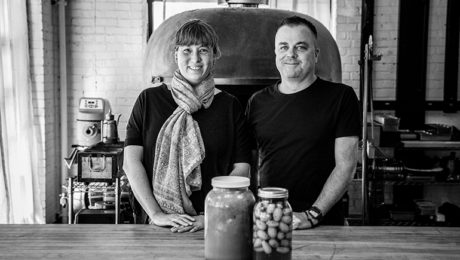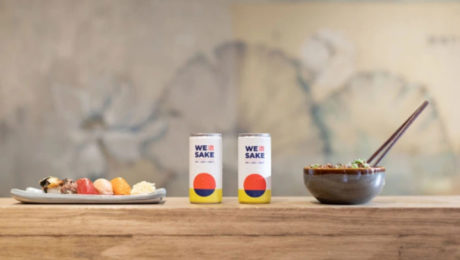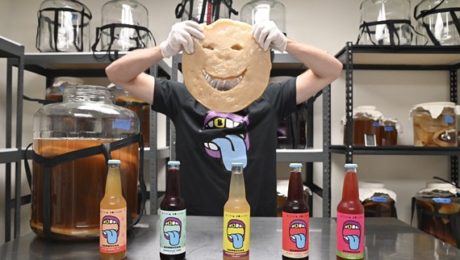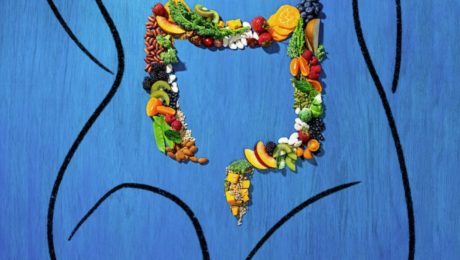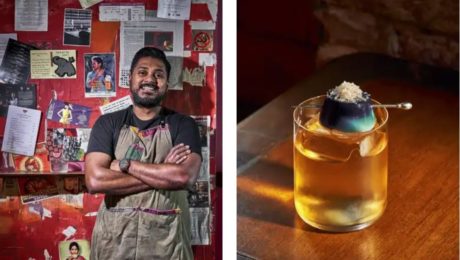Reducing Waste, Cost with Fermentation
After hiring a fermentation expert to help reduce food waste, Id Est Hospitality Group saw their food cost drop from 32% to 22%. Kelly Whitaker, founder and chef, hired Mara King, fermentation specialist (both pictured), to pursue a zero waste model in the group’s different restaurants. Whitaker points out he doesn’t like using the term “waste” but “other products” instead.
King is chef, co-founder of fermented food business Ozuké, educator and producer of the YouTube series “People’s Republic of Fermentation.” She notes in a climate like Boulder, Colo., preserving food is key.
“As a fermenter, one of the first things Kelly wanted me to dive into was seasonality,” said King. “We live in Colorado and it has a short growing season compared to other places in the world.”
King began a large-scale preservation project at Id Est Hospitality Group, using the produce from local farmers to fuel ideas. For example, she made a vinegar using the discarded peels of 200 persimmons and a hot sauce with more than 90 pounds of 100 types of chiles, with the chiles prepared in different ways (preserved, roasted, frozen or dried).
Read more (Restaurant Hospitality)
- Published in Business, Food & Flavor
Is the Future of Sake Canned?
Despite dedicated U.S. sake programs and educated American sommeliers, sake has been a harder sell in U.S. Federal regulations have never been able to properly define the drink. It’s taxed as a beer, but regulated as a wine. Education is a big issue. Many Americans think sake is a wine, causing them to drink too much of it and feel sick. Sake is brewed from fermented rice, making it similar to a beer.
“There’s a learning curve, but there’s also a bit of a cultural barrier. Sake can come across the way wine can — this very sophisticated product that’s expensive and that’s a bit esoteric, like you can’t really appreciate it unless you know all the nomenclature,” says Weston Konishi, president of the Sake Brewers Association of North America. “And then there’s the fact that Japanese sake tends to be labeled in Japanese, which most Americans can’t read. That’s been something of a barrier.”
Now more sake brewers are putting their sake in cans, making easy-to-purchase, grab-and-go options. It’s cheaper, too, at $5 a can versus $30 for a bottle.
“There’s something less intimidating about a can versus a bottle — that’s one advantage to canning sake. It’s not so erudite and out of reach,” says Konishi.
Inside Hook highlights six brands selling sake in cans.
Read more (Inside Hook)
- Published in Business
Brewing Kombucha for the Haters
In a crowded kombucha marked, Bitchin’ Boucha founder Jason Smith has a unique philosophy to selling the fermented tea. He’s not going after kombucha die-hards, he’s making it for people who don’t like kombucha.
The Richmond, Virginia brand launched eight years ago when Smith tasted kombucha while on a fast from alcohol and processed sugar. He liked it, but thought he could make it taste better.
“Other kombuchas can be too vinegary because most of the ones in stores are bottled and unpalatable,” explains Smith. “Shipping and refrigerating it for too long can kill the flavor because the kombucha is a living thing. Some companies even pasteurize it so it can’t ferment even more, and it kills all the live organisms which defeats the purpose. I make kombucha for people who don’t like kombucha. I want to show people that it can taste good.”
Bitchin’ Boucha debuts a new seasonal flavor every few months. And every batch of Bitchin’ Boucha must pass the taste test with his own kids. Smith says the process to create a new flavor, secure health department approval and bottle it takes two months. Currently, Bitchin’ Boucha produces 15-20 kegs of kombucha a week. Their first official employee besides Smith will start this month, with Smith aiming to sell the kombucha in a grocery store.
Read more (Style Weekly)
- Published in Food & Flavor
Food Regulations Fall Short on Diversity
The laws around food production are confusing, costly and “don’t reflect diversity in food.” Cottage food producer laws allow budding chefs to start making ferments for retail sales, “but only if they’re made a certain way.”
An article in Minnesota Public Radio highlights a major gap in food regulation: immigrants are left out. Though food laws cover fermented kimchi and kombucha, for example, they’re restrictive for less common fermented foods and beverages from different cultures. Vino Raj, owner Square Root of Curry in Minnesota, points out that if he tried to make a fermented product from his native country, he’d have to “fundamentally change” the product to follow the state’s rules, “rendering them inauthentic.”
“You don’t see lots of South Indian foods because of that law,” he said. “The laws have not caught up to other forms of cooking.”
The barriers for immigrants wanting to start a small food business are especially high. Procedures often aren’t translated into other languages, commercial kitchens are challenging to find and expensive to rent, insurance and licensing is costly.
Pictured, Dao See, owner of Minne Street Rolls, sells traditional Lahu food and is advocating for Minnesota to sell more diverse food.
Read more (Minnesota Public Radio)
- Published in Business
Consumers: We’d Eat More Fermented Foods if Knew Health Benefits
The general public lacks knowledge of fermentation and does not understand the health benefits. Nearly 85% of respondents in a survey said they would consume more fermented foods if they knew more about fermentation’s health benefits.
The study illustrates much work is needed in educating consumers. Over 83% of respondents didn’t know the definition of fermentation and over 60% had limited knowledge of the microorganisms involved in fermentation. Most learned about fermented foods at school (31%), the internet (29%) or home (26%). And 72% said they felt safe consuming fermented foods.
Researchers from the University of Maribor in Slovenia studied how much people in the country know about fermentation. The results were eye-opening, especially since fermentation is more common in Europe. The study notes Slovenians commonly grow up eating local fermented foods, like sauerkraut, sour turnip and sour milk, especially in rural areas.
“Despite the fact that less than one fifth of the participants were familiar with the definition of fermentation and understood the process, almost one-third of the participants at least tried to ferment at home,” the study concludes. “Fermented foods should once again become part of the diet to improve overall health and reduce or postpone the onset of a variety of chronic diseases that plague us today.”
Read more (BMC Public Health)
Inuit Scientist on Ferments of the Arctic
When Aviaja Lyberth Hauptmann, PhD, began her research into the metagenomics of snow and ice environments, she was surprised that plant-based diets were a constant focus in the field of human gut microbiome research.
“I wondered why no one seemed to acknowledge that some peoples, and in particular Arctic Indigenous peoples, have lived healthily off animal-source foods for millennia,” she says. “It was clear to me that there is a large gap in our understanding of how healthy animal-source foods affect the microbiome. And not just animal-source foods, but foods that are not industrially produced, foods that come straight out of our environment, including microbes from our environment.”
This has become central to Hauptmann’s research. She’s published two papers on Inuit foods. Her latest, on Inuit ferments, was published with Maria Marco, PhD, food science professor at University of California, Davis (TFA Advisory Board member). That study, published in the journal Microbiome Research Reports, concluded the way to “understand the value of these traditional animal-sourced foods” is to combine new microbiological techniques with projects led by the Inuit “who make and consume fermented foods.”
In an interview with Microbiome Research Reports, Hauptmann notes that most people consider the Arctic a harsh, barren and cold place. “But Inuit describe the vast sea ice as some might describe a garden. It is full of life and food. The Arctic is a source of diverse and abundant diets if one knows how to tap into the abundance and diversity, and an important aspect of that is food preservation and of course fermentation.” Inuit store meat and other food when it’s been abundant, so fermentation has played a central role for the last 300 years. She hopes Inuit people will still take part in that local culture, eating and preserving the local foods.
Read more (Microbiome Research Reports)
- Published in Food & Flavor, Science
10 Year Old Ferment Brand Shuts Down
After 10 years in business, DC-based ferment shop Number 1 Sons has closed, victim to one of the hardships for many small food producers: operation woes.
Number 1 Sons exclusively sold at farmers markets. Their seasonal ferments ranged from pickles, sauerkraut, kimchi, kombucha and vinegar.
They were one of the early adopters of home delivery when the pandemic hit, investing in six refrigeration vans and making over 30,000 home deliveries in 2020 and 2021. In 2022, they returned to selling at farmers markets. But owners and siblings Yi Wah and Caitlin Roberts said in a statement that they can no longer operate in their current space.
“Since 2012, we’ve made pickled and fermented food and drink that we’ve brought to our neighbors at farmers’ markets across the Washington DC area,” they said. “In the spring of 2020, we transformed overnight from a farmers market pickle company into a pandemic grocery delivery business. Such a business transformation is only possible with incredible community or massive resources. Guess which one we had? Our customers trusted us.”
In a statement, Wah and Roberts said: “many businesses are facing rising costs and an increasingly challenging business environment – we recognize our fellow food businesses that are continuing to evolve, innovate, and grind it out. Local independent businesses are key fibers in the community tapestry.”
“We are thankful, and in awe, of our customers, crew, fellow market businesses, and partners (microbes too!) who have been a part of this salty little thing. It’s been a gift to do this with you.”
Read more (Washingtonian)
- Published in Business
Nourishing Microbiota With Fermented Foods
The gut microbiome and how fermented foods can nourish it topped the Washington Post headlines in September. The article shared highlights from the growing number of studies that suggest “these vast communities of microbes are the gateway to your health and well-being — and that one of the simplest and most powerful ways to shape and nurture them is through your diet.” Food (and environment and lifestyle behaviors) have a much larger impact on the gut microbiome than genetics.
The article by health reporter Anahad O’Conner says science proves diverse diets make diverse gut microbiomes. Lower rates of microbiome diversity is linked to chronic diseases like obesity, diabetes and rheumatoid arthritis.
One way to increase that diversity is by eating fermented foods – the article points out yogurt, kimchi, sauerkraut, kombucha and kefir as excellent examples.
“The microbes in fermented foods, known as probiotics, produce vitamins, hormones and other nutrients. When you consume them, they can increase your gut microbiome diversity and boost your immune health, said Maria Marco, a professor of food science and technology who studies microbes and gut health at the University of California, Davis.”
A study by researchers at Stanford – and published last year in the journal Cell – found people who eat fermented food regularly increase their gut microbial diversity and lower their levels of inflammation.
“While it’s clear that eating lots of fiber is good for your microbiome, research shows that eating the wrong foods can tip the balance in your gut in favor of disease-promoting microbes,” writes O’Connor. The “bad” microbes, according to research, are commonly found in highly processed foods “that are low in fiber and high in additives such as sugar, salt and artificial ingredients. This includes soft drinks, white bread and white pasta, processed meats and packaged snacks like cookies, candy bars and potato chips.
Tim Spector, professor of epidemiology at King’s College London and the founder of the British Gut Project, tells the Washington Post that eating a wide variety of plants, fiber and nutrient-dense foods is also beneficial for the gut. Spector encourages people to eat 30 different plant foods a week, which can include produce, nuts, herbs and spices.
Read more (The Washington Post)
Local Flavors Drive Singapore’s Growing Craft Cocktail Scene
Fifteen years ago, Singapore’s craft cocktail scene was nonexistent. The few existing cocktail bars served beer and whisky. Today, Singapore is filled with world-class venues serving unique drinks that highlight the regional ingredients and culture of the southeast Asian metropolis.
The National Geographic explores “the city-state’s roster of award-winning drinking dens includes stellar hotel bars, sleek speakeasies and reimagined Chinatown shophouses.”
Creative drinks include those served by Nutmeg & Clove. Its Singapore-inspired cocktail list features a changing bar menu, like the current cocktail Can Bubble Gum?, a mezcal-based drink topped with candy-flavored foam. The drink is a tongue-in-cheek jab at Singapore’s ban on chewing gum. Another unique cocktail, the Oyster Omelette, is served at bar Native. The yellow, umami-packed drink is made with a base of distillate of oysters harvested off a nearby island, Pulau Ubin. The drink is served, appropriately, in a cup made of oyster shells.
“When we opened eight years ago, there were a few cocktail bars in Singapore, but they were mainly quite international,” says Colin Chia, owner of Nutmeg & Clove. “I wanted to set up something that we could proudly call a Singaporean cocktail bar.”
While sourcing can be a challenge in Singapore – an island off southern Malaysia – bars get creative. Menus are seasonal, ingredients are local and often cured, pickled or fermented to extend shelf life. Pictured, Yugnes Susela, the owner and bartender of The Elephant Room, that focuses the establishment on the colorful markets of Singapore enclave Little India. The drink is the Peranakan cocktail at Native Bar.
Read more (National Geographic)
- Published in Food & Flavor
Chefs Turn to Fish Sauce for Flavor Punch
Fish sauce has been used for centuries as a umami “flavor bomb” for dishes. An article in British Post Magazine highlights how chefs throughout the world use regional variations of fish sauce – from Vietnamese nuoc mam, Malaysian belacan, Filipino bagoong and Italian colatura.
“Fermentation has been an integral part of many traditional food cultures to develop flavourful foodstuffs,” says Ana San Gabriel, who specializes in umami taste receptors and physiology at food and biotech company Ajinomoto.
San Gabriel details that fish sauce is made from the proteins (myosin, troponin and titin) from the flesh of fish that are broken into umami compounds (peptides and free glutamate) through salting and fermentation.
Belacan is a staple of Malaysia’s coastal cuisine. It’s a shrimp paste used in curries and sambals.
“Belacan has a deep history and heritage in Malaysia, and for many locals it evokes fond memories of family gathered together to make it from scratch,” says Jasper Chow, the executive sous chef at One&Only Desaru Coast, a luxury beachfront resort in Malaysia. “Making belacan is a delicate process that reminds us of the simple yet sophisticated methods of cooking that survive even until today.”
In Vietnam, nuoc mam is made in the southern island of Phu Quoc. It can be made from fish, shrimp or crab.
“As a dip, it highlights the sweetness and clears the greasiness of meat and deep-fried bites. It gives an exciting flavor to, yet never buries, the beautiful natural taste of fresh rolls,” says Pham Van Nhuong, the sous chef in the kitchen at Vietnam’s Tempus Fugit. “As a seasoning, unlike salt, it adds to braises, stews and even stir-fries a vigorous flavor and a signature scent.”
Bagoong in the Philippines is made from fish or krill.
“Bagoong is one of the building blocks of umami, or linamnam, in Philippine cuisine. Sometimes it’s used as a condiment or flavor for an existing dish, sometimes it will be the actual component or basic building block of a dish – like the dish binagoongan, which literally means ‘you used bagoong’,” says chef Jordy Navarra, chef at Toyo in Manila.
Colatura di alici is Italy’s modern version of garum, made from salted and fermented anchovies along Italy’s Amalfi Coast.
“We use colatura as a subtle addition to many dishes and in doing so have nearly completely removed the use of sea salt for sauces and purées,” says Antimo Maria Merone (pictured), chef at Neapolitan restaurant Estro in Hong Kong. “This allows us to precisely reach the level of sapidity by adding a certain percentage of fish sauce to the preparations that lack natural umami.”
Read more (Post Magazine)
- Published in Food & Flavor

